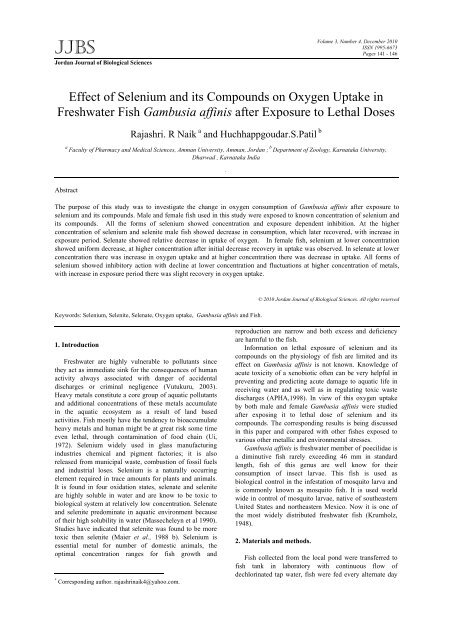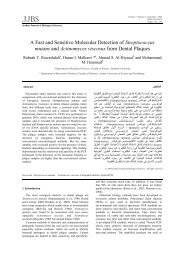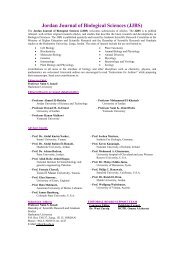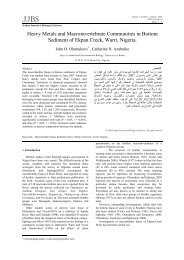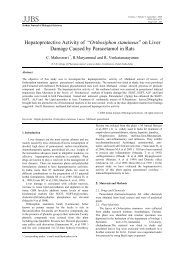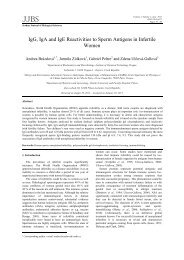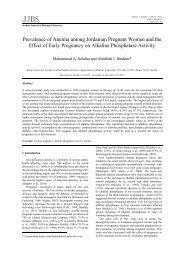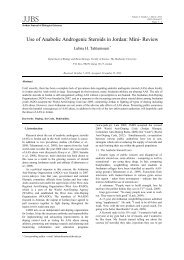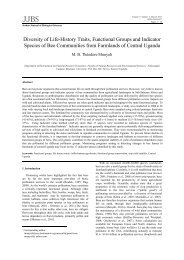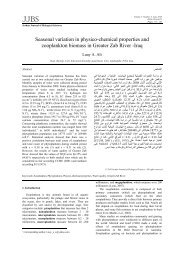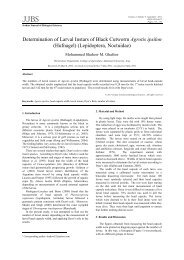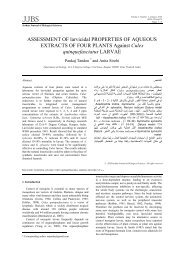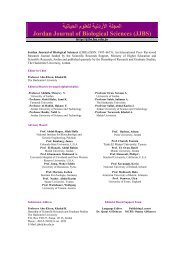Number 4 - Jordan Journal of Biological Sciences
Number 4 - Jordan Journal of Biological Sciences
Number 4 - Jordan Journal of Biological Sciences
You also want an ePaper? Increase the reach of your titles
YUMPU automatically turns print PDFs into web optimized ePapers that Google loves.
JJBS<br />
<strong>Jordan</strong> <strong>Journal</strong> <strong>of</strong> <strong>Biological</strong> <strong>Sciences</strong><br />
Volume 3, <strong>Number</strong> 4, December 2010<br />
ISSN 1995-6673<br />
Pages 141 - 146<br />
Effect <strong>of</strong> Selenium and its Compounds on Oxygen Uptake in<br />
Freshwater Fish Gambusia affinis after Exposure to Lethal Doses<br />
Rajashri. R Naik a and Huchhappgoudar.S.Patil b<br />
a Faculty <strong>of</strong> Pharmacy and Medical <strong>Sciences</strong>, Amman University, Amman, <strong>Jordan</strong> ; b Department <strong>of</strong> Zoology, Karnataka University,<br />
Abstract<br />
Dharwad , Karnataka India<br />
.<br />
The purpose <strong>of</strong> this study was to investigate the change in oxygen consumption <strong>of</strong> Gambusia affinis after exposure to<br />
selenium and its compounds. Male and female fish used in this study were exposed to known concentration <strong>of</strong> selenium and<br />
its compounds. All the forms <strong>of</strong> selenium showed concentration and exposure dependent inhibition. At the higher<br />
concentration <strong>of</strong> selenium and selenite male fish showed decrease in consumption, which later recovered, with increase in<br />
exposure period. Selenate showed relative decrease in uptake <strong>of</strong> oxygen. In female fish, selenium at lower concentration<br />
showed uniform decrease, at higher concentration after initial decrease recovery in uptake was observed. In selenate at lower<br />
concentration there was increase in oxygen uptake and at higher concentration there was decrease in uptake. All forms <strong>of</strong><br />
selenium showed inhibitory action with decline at lower concentration and fluctuations at higher concentration <strong>of</strong> metals,<br />
with increase in exposure period there was slight recovery in oxygen uptake.<br />
Keywords: Selenium, Selenite, Selenate, Oxygen uptake, Gambusia affinis and Fish.<br />
1. Introduction *<br />
Freshwater are highly vulnerable to pollutants since<br />
they act as immediate sink for the consequences <strong>of</strong> human<br />
activity always associated with danger <strong>of</strong> accidental<br />
discharges or criminal negligence (Vutukuru, 2003).<br />
Heavy metals constitute a core group <strong>of</strong> aquatic pollutants<br />
and additional concentrations <strong>of</strong> these metals accumulate<br />
in the aquatic ecosystem as a result <strong>of</strong> land based<br />
activities. Fish mostly have the tendency to bioaccumulate<br />
heavy metals and human might be at great risk some time<br />
even lethal, through contamination <strong>of</strong> food chain (Ui,<br />
1972). Selenium widely used in glass manufacturing<br />
industries chemical and pigment factories; it is also<br />
released from municipal waste, combustion <strong>of</strong> fossil fuels<br />
and industrial loses. Selenium is a naturally occurring<br />
element required in trace amounts for plants and animals.<br />
It is found in four oxidation states, selenate and selenite<br />
are highly soluble in water and are know to be toxic to<br />
biological system at relatively low concentration. Selenate<br />
and selenite predominate in aquatic environment because<br />
<strong>of</strong> their high solubility in water (Massecheleyn et al 1990).<br />
Studies have indicated that selenite was found to be more<br />
toxic then selenite (Maier et al., 1988 b). Selenium is<br />
essential metal for number <strong>of</strong> domestic animals, the<br />
optimal concentration ranges for fish growth and<br />
* Corresponding author. rajashrinaik4@yahoo.com.<br />
© 2010 <strong>Jordan</strong> <strong>Journal</strong> <strong>of</strong> <strong>Biological</strong> <strong>Sciences</strong>. All rights reserved<br />
reproduction are narrow and both excess and deficiency<br />
are harmful to the fish.<br />
Information on lethal exposure <strong>of</strong> selenium and its<br />
compounds on the physiology <strong>of</strong> fish are limited and its<br />
effect on Gambusia affinis is not known. Knowledge <strong>of</strong><br />
acute toxicity <strong>of</strong> a xenobiotic <strong>of</strong>ten can be very helpful in<br />
preventing and predicting acute damage to aquatic life in<br />
receiving water and as well as in regulating toxic waste<br />
discharges (APHA,1998). In view <strong>of</strong> this oxygen uptake<br />
by both male and female Gambusia affinis were studied<br />
after exposing it to lethal dose <strong>of</strong> selenium and its<br />
compounds. The corresponding results is being discussed<br />
in this paper and compared with other fishes exposed to<br />
various other metallic and environmental stresses.<br />
Gambusia affinis is freshwater member <strong>of</strong> poecilidae is<br />
a diminutive fish rarely exceeding 46 mm in standard<br />
length, fish <strong>of</strong> this genus are well know for their<br />
consumption <strong>of</strong> insect larvae. This fish is used as<br />
biological control in the infestation <strong>of</strong> mosquito larva and<br />
is commonly known as mosquito fish. It is used world<br />
wide in control <strong>of</strong> mosquito larvae, native <strong>of</strong> southeastern<br />
United States and northeastern Mexico. Now it is one <strong>of</strong><br />
the most widely distributed freshwater fish (Krumholz,<br />
1948).<br />
2. Materials and methods.<br />
Fish collected from the local pond were transferred to<br />
fish tank in laboratory with continuous flow <strong>of</strong><br />
dechlorinated tap water, fish were fed every alternate day


